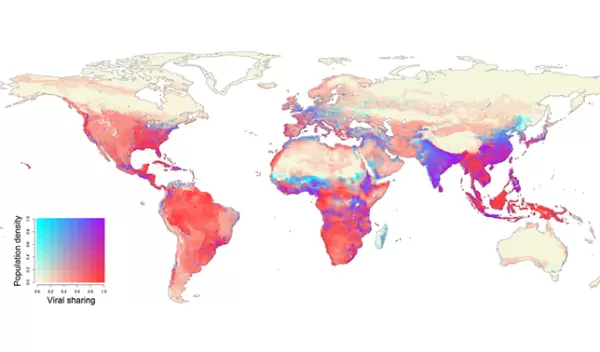
Study finds that climate change could spark the next pandemic
As Earth's climate continues to warm, researchers predict that wild animals will be forced to relocate their habitats -- likely to regions with large human populations -- dramatically increasing the risk of a viral jump to humans that could lead to the next pandemic.
The link between climate change and viral transmission is described by an international research team led by scientists at Georgetown University and published in Nature. The study is funded by the U.S. National Science Foundation.
"The COVID-19 pandemic, and the previous spread of SARS, Ebola, and Zika, show how a virus jumping from animals to humans can have massive effects," said Sam Scheiner, a program director in NSF's Division of Environmental Biology. "To predict the jump to humans, we need to know about spread among other animals. This research shows that animal movements and interactions due to a warming climate might increase the number of viruses jumping between species."
The scientists conducted the first comprehensive assessment of how climate change will restructure the global mammalian virome. The work focuses on geographic range shifts -- the journeys that species will undertake as they follow their habitats into new areas. As they encounter other mammals for the first time, the study projects they will share thousands of viruses.
These shifts bring greater opportunities for viruses such as Ebola or coronaviruses to emerge in new areas, making them harder to track, and into new types of animals, making it easier for viruses to jump across "stepping stone" species into humans.
"The closest analogy is the risks we see in the wildlife trade," says the study's lead author, Colin Carlson of Georgetown University Medical Center. "We worry about markets because bringing unhealthy animals together in unnatural combinations creates opportunities for this stepwise process of emergence – such as how SARS jumped from bats to civets, then civets to people. But markets aren't special anymore; in a changing climate, that kind of process will be the reality in nature just about everywhere."
Rising temperatures will have a major impact on bats, for example, which account for the majority of novel virus-sharing. Their ability to fly allows them to travel long distances and share the most viruses. Because of bats' central role in viral emergence, the greatest impacts are projected in southeast Asia, a global hotspot of bat diversity.
The study suggests that climate change will become the biggest upstream risk factor for disease emergence -- exceeding higher-profile issues such as deforestation, wildlife trade and industrial agriculture. The authors say the solution is to pair wildlife disease surveillance with real-time studies of environmental change.
"When a Brazilian free-tailed bat makes it all the way to Appalachia,” says Carlson, “we should be invested in knowing what viruses are tagging along.”
